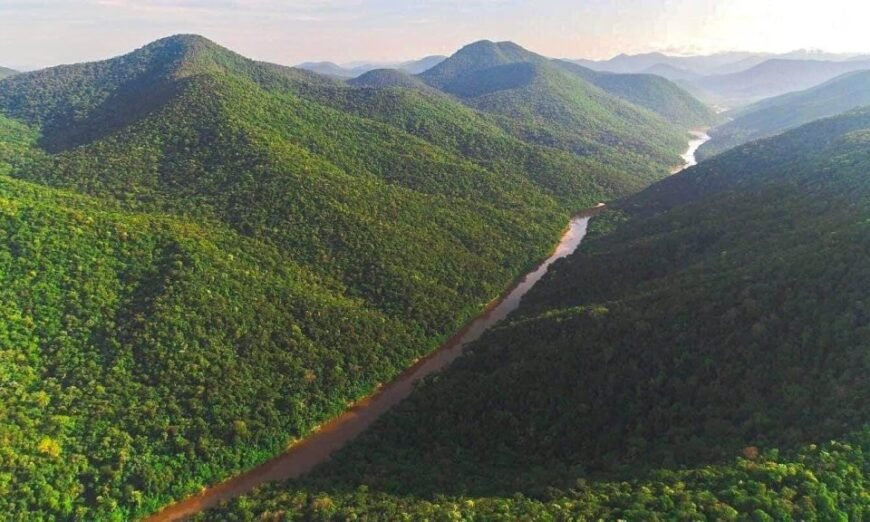Guyana’s Low Carbon Development Strategy (LCDS) 2030 represents a bold and transformative approach to balancing national development with global climate leadership. Originally launched in 2009, the LCDS was the first strategy of its kind from a developing country, aiming to map out a future where economic progress goes hand-in-hand with environmental preservation. The updated LCDS 2030 is the result of an extensive seven-month national consultation process involving citizens, civil society, Indigenous groups, and the private sector. It provides a comprehensive framework to guide Guyana’s development trajectory while addressing the climate crisis, fostering biodiversity conservation, and unlocking the value of ecosystem services.
Guyana is uniquely positioned in the global climate landscape. It maintains the second highest percentage of forest cover on Earth, with over 18 million hectares—amounting to more than 99% of its original forest—still intact. These forests store approximately 19.5 billion tons of carbon dioxide equivalent, offering one of the largest per capita carbon sinks globally. Despite its small population and relatively low carbon footprint, Guyana’s ecological assets play an outsized role in stabilizing the global climate. The country is also one of just four in the world—and one of only two in the Amazon basin—that holds the status of High Forest, Low Deforestation (HFLD). This designation reflects its exceptional success in maintaining healthy forest cover while keeping deforestation rates among the lowest worldwide.
Situated within the Guiana Shield, Guyana shares in one of the planet’s most pristine and biologically diverse ecosystems. This ancient geological formation stores nearly 18% of the world’s tropical forest carbon and around 20% of the world’s freshwater. Guyana’s biodiversity is equally impressive, harboring approximately 4% of all known animal species, including jaguars, giant river otters, and harpy eagles. Moreover, the country’s coastal and marine environments—comprising more than half the area of its terrestrial landscape—present a new frontier for development, especially under the umbrella of the emerging Blue Economy. The LCDS 2030 recognizes these marine assets and integrates their sustainable use into the broader national strategy.
The LCDS 2030 sets out four key objectives: to value ecosystem services; invest in clean energy while stimulating low-carbon growth; protect against climate change and biodiversity loss; and align with international climate goals. A major success story of the LCDS framework is the groundbreaking Guyana-Norway partnership, launched in 2009. Under this bilateral agreement, Norway paid Guyana over USD 212 million between 2009 and 2015 in exchange for preserving its forests. These funds were directed into renewable energy, climate adaptation, land titling, and social development. One of the most important legacies of this phase was the creation of a world-class Monitoring, Reporting and Verification System (MRVS), which tracks changes in forest cover and carbon emissions with a high degree of accuracy.
Following this success, Guyana turned to voluntary carbon markets as a sustainable financing mechanism for forest conservation. In 2022, the country made history once again by becoming the first to be issued carbon credits under the Architecture for REDD+ Transactions (ART) through the TREES standard. This independent mechanism validates high-integrity forest carbon credits aligned with the Paris Agreement. Guyana secured a major deal with Hess Corporation, selling 37.5 million credits for a value of up to USD 750 million over ten years. Importantly, 15% of these revenues are earmarked for Indigenous communities, empowering them to implement Village Sustainability Plans that prioritize local development in harmony with environmental protection.
In addition to carbon finance, LCDS 2030 outlines a comprehensive clean energy agenda. The strategy includes the development of a 300 MW gas-to-energy project, the Amaila Falls Hydropower Project, and the nationwide distribution of 30,000 solar photovoltaic systems. These initiatives aim to cut electricity costs, reduce dependency on imported fossil fuels, and position Guyana as a model of green industrialization. The strategy also emphasizes climate adaptation, including coastal zone management, flood control, sustainable agriculture, and expanded conservation zones. It supports the goal of increasing Guyana’s protected areas from 8.5% to 30% of its national territory.
A defining feature of the LCDS is its emphasis on equity and inclusivity. The strategy commits to transparent governance and participatory decision-making, ensuring that all sectors of society—especially Indigenous peoples and hinterland communities—have a stake in shaping and benefiting from low-carbon development. In doing so, the LCDS not only safeguards the environment but also improves livelihoods, strengthens social cohesion, and fosters long-term resilience.
Guyana’s LCDS 2030 stands as a pioneering model for how natural resource-rich developing countries can transition toward a low-carbon economy without sacrificing development goals. Through strategic international partnerships, innovative carbon finance mechanisms, and an unwavering commitment to sustainability, Guyana has positioned itself as a global leader in climate action. As the world grapples with the escalating climate emergency, the LCDS offers a replicable blueprint for how nations can build prosperity while protecting the planet.

